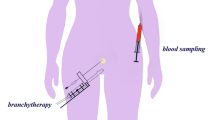Abstract
A Rayleigh damping model applied to magnetic resonance elastography incorporates attenuation behavior proportionally related to both elastic and inertial forces, and allows two damping parameters to be extracted from an MRI motion dataset. Under time-harmonic conditions, the model can be implemented by the use of complex shear modulus and density, whereas viscoelastic damping models commonly used in elastography consist of only a complex shear modulus, and model only a single damping effect. Simulation studies reveal that the differences between damped elastic behavior resulting from a purely complex shear modulus (CSM damping) and from a purely complex density (CD damping) become larger as the overall level of damping present (indicated by the damping ratio) increases. A plot of results generated from the finite element (FE) model indicate the relative motion differences estimated for a range of damping ratios and CSM/CD damping combinations increase with damping ratio, and can be up to 15% at a damping ratio of 50% and therefore using the correct model for a Rayleigh damped material becomes increasingly important as damping levels increase. Resonance-related effects cause values from this plot to vary by as much as 3% as parameters such as wave speed, frequency, and problem size are altered. These motion differences can be compared to expected noise levels to estimate the parameter resolution achievable by a reconstruction algorithm. An optimization-based global property reconstruction algorithm was developed, and used for testing Rayleigh damping parameter reconstructions with gaussian noise added to the simulated motion input data. The coherent motion errors resulting from altering the combination of the two damping parameters are large enough to allow accurate determination of both of the Rayleigh damping parameters with incoherent noise levels comparable to MR measurements. The accuracy achieved by the global reconstructions was significantly better than would be predicted by examining the motion differences for differing CSM/CD damping combinations, which is likely to be due to the low ratio between number of reconstructed parameters and number of noisy measurements.




Similar content being viewed by others
References
Bland DR (1960) The theory of linear viscoelasticity. Pergamon Press, Oxford
Cook RD, Malkus DS, Plesha ME, Witt RJ (2002) Concepts and applications of finite element analysis, 4th edn. Wiley, New York
Flugge W (1975) Viscoelasticity, second revised edition. Springer, Berlin
Manduca A, Oliphant TE, Dresner MA, Kruse JL, Amromin E, Felmlee JP, Greenleaf JF, Ehman RL (2001) Magnetic resonance elastography: non-invasive mapping of tissue elasticity. Med Image Anal 5:237–254
McGarry MDJ, Berger HU, Van Houten EEW (2007) Damping models in elastography. In: Proceedings-medical imaging-SPIE, vol 6511, Feb. 17–22, 2007, San Diego, CA, USA
Muthupillai R, Lomas DJ, Rossman PJ, Greenleaf JF, Manduca A, Ehman RL (1995) Magnetic resonance elastography by direct visualization of propagating acoustic strain waves. Science 269:1854–1857
Nocedal J, Wright SJ (1999) Numerical optimization. Springer, New York
Oliphant TE, Manduca A, Ehman RL, Greenleaf JF (2001) Complex-valued stiffness reconstruction for magnetic resonance elastography by algebraic inversion of the differential equation. Magn Reson Med 45:299–310
Ortega JM, Rheinboldt WC (2000) Iterative Solution of Nonlinear Equations in Several Variables. Society for Industrial and Applied Mathematics, Philadelphia
Semblat JF (1997) Rheological interpretation of rayleigh damping. J Sound Vib 206:741–744
Sinkus R, Tanter M, Catheline S, Lorenzen J, Kuhl C, Sondermann E, Fink M (2005) Imaging anisotropic and viscous properties of breast tissue by magnetic resonance-elastography. Magn Reson Med 53:372–387
Sinkus R, Tanter M, Xydeas T, Catheline S, Bercoff J, Fink M (2005) Viscoelastic shear properties of in vivo breast lesions measured by MR elastography. Magn Reson Imaging 23:159–165
Van Houten EEW, Doyley MM, Kennedy FE, Weaver JB, Paulsen KD (2003) Initial in-vivo experience with steady-state subzone-based MR elastography of the human breast. J Magn Reson Imaging 17:72–85
Van Houten EEW, Doyley MM, Kennedy FE, Paulsen KD, Weaver JB (2005) A three-parameter mechanical property reconstruction method for MR-based elastic property imaging. IEEE Trans Med Imaging 24:311–324
Zienkiewicz OC, Taylor RL (2000) The finite element method, vol 1, the basis. Butterworth-Heinemann, Newton
Acknowledgments
We gratefully acknowledge support from NIH/NIBIB R01-EB004632-02.
Author information
Authors and Affiliations
Corresponding author
Rights and permissions
About this article
Cite this article
McGarry, M.D.J., Van Houten, E.E.W. Use of a Rayleigh damping model in elastography. Med Biol Eng Comput 46, 759–766 (2008). https://doi.org/10.1007/s11517-008-0356-5
Received:
Accepted:
Published:
Issue Date:
DOI: https://doi.org/10.1007/s11517-008-0356-5




